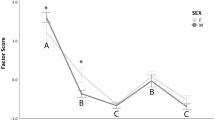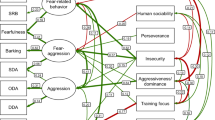Abstract
This article is a condensed life-history of a dog (“V3”) born and reared in the Pavlovian Laboratory and studied until his death in 1961. A detailed study was made of his pathologic development, his relations to people, and the effects of drugs. Measurements recorded were heart rate, blood pressure, respiration, 24-hour activity, sexual reflexes, general behavior. Although early experiments were done chiefly for recording and were not considered noxious or traumatic, this dog’s general development and symptoms seem to have been “constitutionally” rather than environmentally determined. His external behavior was strikingly similar to that of a catatonic patient-flexibilitas cerea, general immobility. Of particular interest was the “Effect of Person”: in the presence of all humans who confronted him he showed catatonic postures, cardiovascular disorders (tachycardia up to 200 beats/min., bradycardia to 12 beats/min., drop of blood pressure from 150 to 75 mm Hg, arrest of heart-beat for as long as 8 seconds), moribund poses. His response to drugs illustrated the specificity to a definite “constitutional type”: sexual activity markedly increased by alcohol and rarely present except after administration of alcohol; no improvement after administration of tranquilizers, except alcohol and meprobamate, which made him act like a normal dog in behavior and in relations to people. His symptoms and reactions to both people and drugs were generally opposite to those of another dog, “Nick”, studied over his life span: Nick showed excessive activity in physiologic systems; hyperactivity (running); generally, improvement through “Effect of Person”; sexual inhibition with alcohol. Observations of the two dogs suggest that symptoms as well as reactions to drugs are the result of the “type” rather than the procedure used, that perhaps psychopathologic symptoms are due more to inborn constitution than to “conflict” (“collision”) between excitation and inhibition, and that neurotic or psychotic symptoms may not interfere with longevity-Nick lived to be 14 years old and died fighting; V3, who also spent most of his life in the laboratory, died at the age of 14.
Similar content being viewed by others
References
Gantt, W. H.:Experimental Basis for Neurotic Behavior. Paul B. Hoeber, Inc., New York, 1944.
Gantt, W. H.: Effect of alcohol on the sexual reflexes of normal and neurotic male dogs.Psychosom. Med.,14: 174–181, 1952.
Gantt, W. H.: Principles of nervous breakdown-schizokinesis and autokinesis.Ann. N. Y. Acad. Sci. 56: 143–163, 1953.
Gantt, W. H., Newton, J. E. O., Royer, F. L., and Stephens, J. H.: Effect of Person.Cond. Reflex,1: 18–35, 1966.
Liddell, H. S.: Some specific factors that modify tolerance for environmental stress.Troc. Assoc. Res. Nerv. Ment. Dis.,29: 155–171, 1949.
Murphree, O. D., Peters, J. E., and Dykman, R. A.: Effect of Person on nervous, stable and crossbred pointer dogs.Cond. Reflex,2: 273–276, 1967.
Williams, C. H., and Livingston, A.: Increased excretion of histidine found in paper Chromatographic survey of dog urines.J. Nerv. Ment. Dis.,137: 395–399, 1963.
Author information
Authors and Affiliations
Additional information
This work was supported in part by grants from the American Heart Association to W. H. Gantt, and was done while J. E. O. Newton had a postdoctoral fellowship from the National Institute of Mental Health of the U. S. Public Health Service.
Rights and permissions
About this article
Cite this article
Newton, J.E.O., Gantt, W.H. The history of a catatonic dog. Conditional Reflex 3, 45–61 (1968). https://doi.org/10.1007/BF03001136
Issue Date:
DOI: https://doi.org/10.1007/BF03001136




